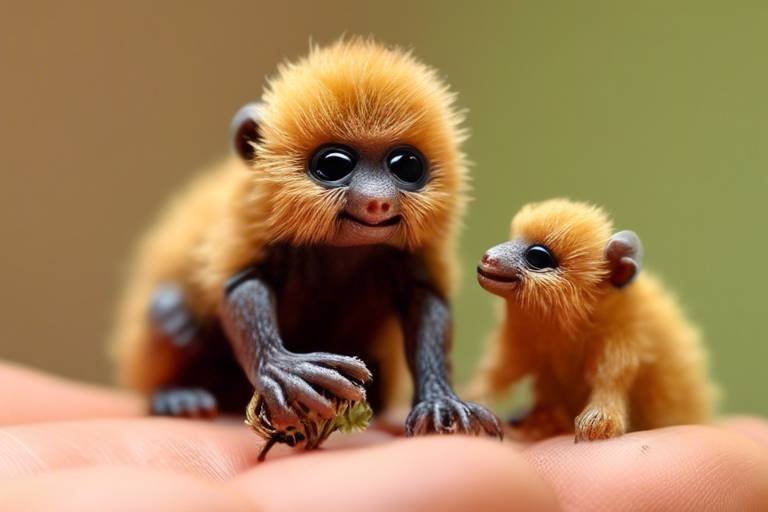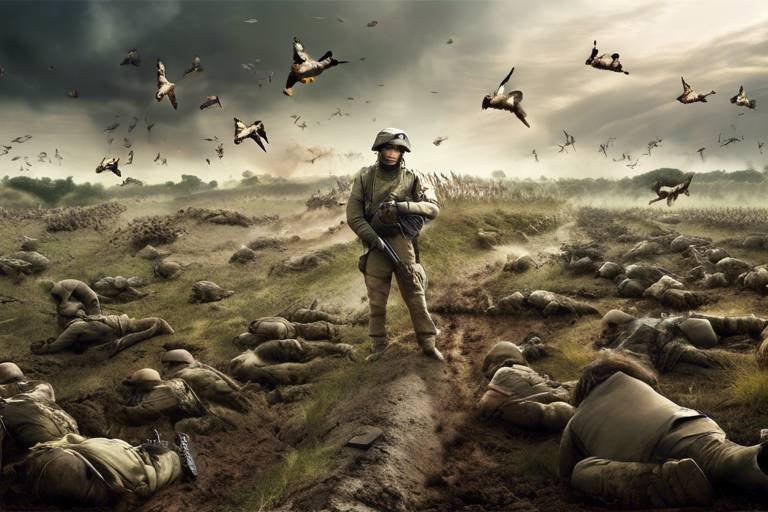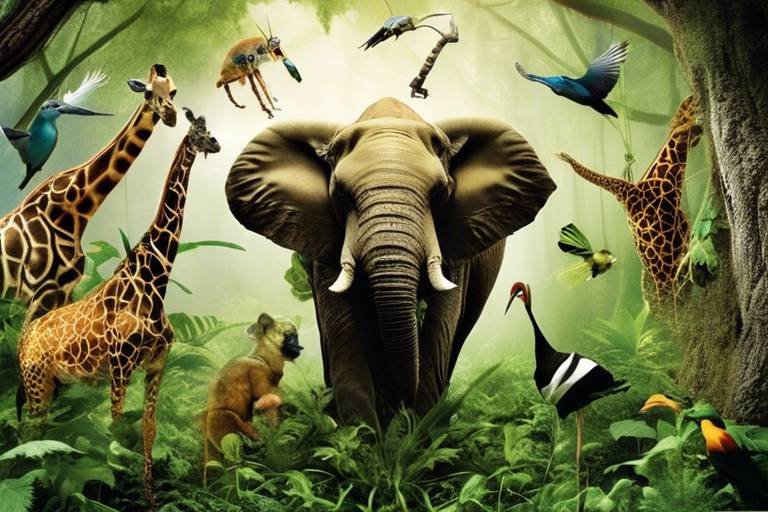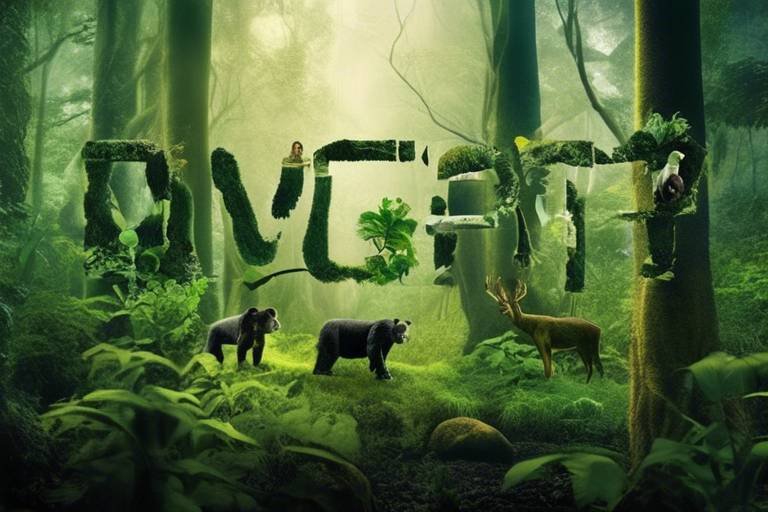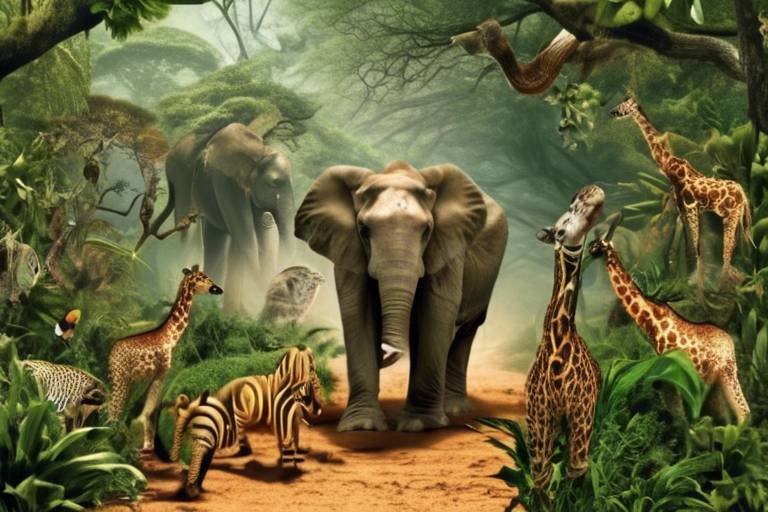Covid-19: A Caution against Disturbing Wildlife and Their Habitats
The Covid-19 pandemic has been a wake-up call for humanity, revealing the intricate connections between our health and the health of wildlife and their habitats. As we navigate through the challenges posed by this virus, it becomes increasingly evident that our actions towards wildlife can have profound implications not just for animal populations but also for human health. The emergence of zoonotic diseases, which are diseases that jump from animals to humans, underscores the importance of respecting and preserving natural environments. By disturbing wildlife and their habitats, we inadvertently increase the risk of these diseases spilling over into human populations, making it essential for us to rethink our relationship with nature.
Understanding the delicate balance within ecosystems is crucial. Wildlife serves as a reservoir for various pathogens, and when their habitats are disrupted, the stress on these animals can lead to altered behaviors, increased contact with humans, and ultimately, the transmission of diseases. For instance, as urban areas expand into previously untouched lands, animals are forced into closer proximity with human populations, creating opportunities for pathogens to jump species. This situation is not just a theoretical concern; it has been observed in numerous instances where habitat encroachment has led to outbreaks of diseases such as Ebola, Zika, and now, Covid-19.
Moreover, the implications of habitat destruction extend beyond just the potential for disease outbreaks. When we destroy natural habitats through urbanization, deforestation, or industrial activities, we are not only endangering wildlife but also compromising the ecological services that these habitats provide. Healthy ecosystems contribute to clean air and water, pollination of crops, and regulation of climate—all of which are vital for human survival. Therefore, it is imperative that we adopt a more harmonious approach towards wildlife conservation and habitat preservation.
As we delve deeper into the complexities of zoonotic diseases and their links to wildlife, we must recognize the urgency of implementing effective conservation strategies. This involves not only protecting existing habitats but also restoring those that have been degraded. By investing in conservation efforts, promoting sustainable practices, and fostering public awareness, we can create a safer environment for both wildlife and humans. The path forward requires collaboration among governments, NGOs, and local communities to ensure that our actions today do not jeopardize the health of future generations.
- What are zoonotic diseases? Zoonotic diseases are infections that are transmitted from animals to humans. They can originate from various wildlife species and can lead to serious health issues.
- How does habitat destruction lead to pandemics? Habitat destruction forces wildlife into closer contact with humans, increasing the chances of disease transmission. This disruption can trigger stress responses in animals, making them more susceptible to infections.
- What can individuals do to help prevent zoonotic diseases? Individuals can contribute by supporting wildlife conservation efforts, reducing their ecological footprint, and advocating for sustainable practices in their communities.
- Why is urban planning important in wildlife conservation? Sustainable urban planning helps minimize habitat destruction and promotes coexistence between humans and wildlife, reducing the risks of zoonotic disease transmission.

The Link Between Wildlife and Zoonotic Diseases
The intricate relationship between wildlife and zoonotic diseases is a topic that has gained significant attention, especially in the wake of the Covid-19 pandemic. Zoonotic diseases are those that jump from animals to humans, and understanding this connection is vital for preventing future outbreaks. It’s like a game of dominoes; when one piece falls, it can set off a chain reaction that impacts us all. Wildlife, often seen as distant and separate from our daily lives, can harbor pathogens that can be transmitted to humans, especially when their habitats are disturbed.
Various factors contribute to the transmission of these diseases. Firstly, the **habitat of wildlife** is often a breeding ground for numerous pathogens. When humans encroach upon these habitats through activities like urbanization, agriculture, and deforestation, they disrupt the natural balance. This disruption can lead to stress in wildlife, which may increase the likelihood of them shedding pathogens. For instance, as animals are forced into closer proximity with humans, the chances of disease transmission rise significantly.
Moreover, the **diversity of wildlife** plays a crucial role in disease dynamics. A rich ecosystem with a variety of species can act as a buffer against disease transmission. However, when specific species are overrepresented due to habitat destruction, it can lead to an increase in zoonotic diseases. For example, certain rodents are known carriers of hantavirus, and as their habitats are altered, human encounters become more frequent, raising the risk of infection.
It’s essential to recognize the **mechanisms** through which these diseases are transmitted. Here are some key pathways:
- Direct Contact: Humans may come into contact with infected wildlife through hunting, pet ownership, or even through contaminated food sources.
- Indirect Contact: Pathogens can be transmitted through vectors such as mosquitoes or ticks, which can carry diseases from wildlife to humans.
- Environmental Exposure: Contaminated water sources or soil can serve as reservoirs for pathogens, leading to outbreaks when humans are exposed.
In essence, the link between wildlife and zoonotic diseases is a complex web of interactions that underscores the importance of preserving natural habitats. By maintaining the integrity of these ecosystems, we not only protect wildlife but also safeguard human health. It’s a classic case of “what’s good for the goose is good for the gander.” When we ensure the health of wildlife, we inherently protect ourselves from potential health crises.
As we move forward, it becomes increasingly clear that **conservation efforts** must be a priority. The health of our planet and its inhabitants is interconnected, and the lessons learned from the Covid-19 pandemic should serve as a wake-up call. By understanding the link between wildlife and zoonotic diseases, we can take proactive steps to prevent future pandemics and promote a healthier coexistence between humans and wildlife.

Impact of Habitat Destruction on Wildlife
Habitat destruction is a pressing concern that has profound implications for wildlife and the ecosystems they inhabit. As we pave the way for urban development, agriculture, and industrial activities, we often forget that we share this planet with a myriad of species that rely on these natural environments for their survival. When we encroach upon their habitats, we don't just displace animals; we disrupt intricate ecological balances that have evolved over millennia. This disruption can lead to a cascade of negative effects, including increased vulnerability to zoonotic diseases like Covid-19.
One of the most alarming consequences of habitat destruction is the fragmentation of wildlife populations. When vast areas of forest or wetlands are cut down or drained, the remaining patches of habitat become isolated. This isolation can lead to inbreeding among animal populations, reducing genetic diversity and making them more susceptible to diseases. In a world where diseases can jump from animals to humans, this genetic bottleneck can have dire consequences for both wildlife and human health.
Moreover, as wildlife habitats shrink, animals are forced to venture into human-dominated landscapes in search of food and shelter. This increased interaction between wildlife and humans creates a perfect storm for disease transmission. For instance, when animals like bats or rodents invade urban areas, they bring with them pathogens that can easily leap to humans. The rise of zoonotic diseases has been closely linked to these types of wildlife encroachments, highlighting the urgent need to address habitat destruction.
To illustrate the impact of habitat destruction, consider the following table that outlines key factors and their consequences:
| Factor | Consequence |
|---|---|
| Urbanization | Increased human-wildlife interactions, leading to higher disease transmission risks. |
| Deforestation | Loss of biodiversity and habitat, causing species displacement and stress. |
| Industrial Activities | Pollution and habitat degradation, which can weaken animal populations and health. |
In addition to these direct impacts, habitat destruction also undermines the natural services ecosystems provide. Healthy ecosystems regulate climate, purify air and water, and even control disease vectors. When we destroy these habitats, we not only harm wildlife but also jeopardize our own health and well-being. It’s a stark reminder that our fates are intertwined; the health of wildlife directly correlates with our own.
As we move forward, it is imperative that we recognize the importance of preserving wildlife habitats. Sustainable practices in urban planning, agriculture, and industry can help mitigate the adverse effects of habitat destruction. By prioritizing conservation efforts and adopting a more harmonious approach to development, we can protect both wildlife and ourselves from the looming threat of zoonotic diseases.
- What is habitat destruction? Habitat destruction refers to the process by which natural habitats are altered or destroyed, often due to human activities like urbanization, agriculture, and industrialization.
- How does habitat destruction affect wildlife? It leads to loss of biodiversity, displacement of species, and increased human-wildlife interactions, which can result in the spread of zoonotic diseases.
- What can be done to prevent habitat destruction? Implementing sustainable practices in urban planning, conserving natural areas, and raising public awareness about the importance of wildlife habitats can help mitigate habitat destruction.
- Why are zoonotic diseases a concern? Zoonotic diseases can jump from animals to humans, posing serious health risks and potentially leading to pandemics, as seen with Covid-19.

Urbanization and Its Effects
Urbanization is like a double-edged sword; on one side, it brings development and progress, but on the other, it often encroaches on wildlife habitats, leading to significant consequences for both animals and humans. As cities expand, they tend to swallow up natural spaces, transforming lush forests and vibrant ecosystems into concrete jungles. This rapid change in land use can disrupt the delicate balance of local ecosystems, making it harder for wildlife to thrive. Have you ever thought about how a bustling city can affect the animal life that once roamed freely in those areas? It's a stark reality that many are unaware of.
When wildlife habitats are fragmented due to urban development, animals are forced to adapt to new environments that may not support their survival. For instance, species that once had ample space to roam may find themselves confined to small patches of land, leading to increased competition for resources such as food and shelter. This struggle can weaken animal populations, making them more susceptible to diseases. The stress of urban life can also lead to changes in animal behavior, pushing them to venture closer to human dwellings in search of food, which increases the risk of zoonotic disease transmission.
Moreover, urban areas often create a unique set of challenges for wildlife. Roads, buildings, and other infrastructure can act as barriers, isolating animal populations and limiting their ability to find mates or migrate. This isolation can lead to inbreeding, which reduces genetic diversity and makes populations more vulnerable to diseases. The impact of urbanization on biodiversity is profound, as many species are pushed to the brink of extinction due to habitat loss and the challenges posed by human activities.
To visualize the effects of urbanization on wildlife, consider the following table that outlines some of the key impacts:
| Impact of Urbanization | Description |
|---|---|
| Habitat Fragmentation | Natural habitats are divided into smaller, isolated patches, making it difficult for wildlife to thrive. |
| Increased Human-Wildlife Interaction | Wild animals venture into urban areas in search of food, leading to conflicts and potential disease transmission. |
| Loss of Biodiversity | Many species face extinction as their habitats are destroyed or altered beyond recognition. |
| Behavioral Changes | Urban stressors can alter animal behavior, making them more aggressive or fearful. |
As we can see, the effects of urbanization are complex and multifaceted. It’s not just about losing green spaces; it’s about the ripple effect that loss has on wildlife and, ultimately, on human health. The relationship between urban development and wildlife is a delicate dance that requires careful consideration and planning. So, how can we strike a balance? By promoting sustainable urban planning and creating wildlife corridors, we can help mitigate these impacts and foster a healthier coexistence between humans and wildlife.
In conclusion, urbanization presents a significant challenge to wildlife, and as we continue to build and expand our cities, we must remain aware of the consequences of our actions. Protecting wildlife habitats is not just an environmental concern; it is a public health issue that affects us all. The next time you walk through a city, take a moment to consider the wildlife that may be adapting to life in the shadows of skyscrapers. Their survival may depend on our willingness to change our approach to urban development.
- What is urbanization?
Urbanization refers to the increasing population in urban areas, leading to the expansion of cities and towns. - How does urbanization affect wildlife?
Urbanization disrupts habitats, increases human-wildlife interactions, and can lead to species extinction. - What can be done to protect wildlife in urban areas?
Implementing sustainable urban planning, creating wildlife corridors, and raising public awareness can help protect wildlife. - Why is biodiversity important?
Biodiversity is crucial for ecosystem stability, resilience, and the provision of resources that humans rely on.

Case Studies of Urban Wildlife Interactions
Urban wildlife interactions have become increasingly common as cities expand and encroach upon natural habitats. These interactions can lead to surprising outcomes, both for wildlife and human populations. For instance, in cities like Los Angeles, the adaptation of coyotes to urban environments has been well-documented. These clever canines have learned to navigate city streets, often scavenging for food in garbage bins or even preying on small pets. As a result, there have been increased reports of coyote encounters, raising concerns about safety and health risks, including the potential transmission of diseases such as rabies.
Another illustrative case is found in the city of Chicago, where raccoons have thrived in urban settings due to the availability of food sources and shelter. These nocturnal creatures have become adept at living alongside humans, often rummaging through trash for leftovers. While they add a certain charm to the urban landscape, their presence also raises significant health concerns. Raccoons can carry parasites like raccoon roundworm, which poses risks to human health, especially for children playing in parks or yards where these animals roam.
Moreover, the interaction between humans and urban birds, such as pigeons and seagulls, presents another layer of complexity. These birds are often seen as nuisances, but they can also act as vectors for diseases like histoplasmosis and cryptococcosis, which can be transmitted through their droppings. In cities like New York, where pigeon populations are abundant, public health officials have had to address the challenges posed by these birds, balancing the need for wildlife coexistence with the imperative to protect human health.
To better understand the implications of urban wildlife interactions, researchers have conducted studies that highlight the need for effective urban planning. For example, a study in Toronto showcased how green spaces can serve as critical habitats for various species while also providing recreational areas for people. However, without proper management, these green spaces can become hotspots for zoonotic disease transmission. Therefore, urban planners must consider both wildlife conservation and public health in their designs.
In summary, urban wildlife interactions are multifaceted and can lead to both positive and negative outcomes. Through analyzing these case studies, it becomes evident that sustainable urban planning and wildlife management are essential to mitigate health risks while promoting biodiversity. The need for a harmonious coexistence between humans and wildlife is more pressing than ever, as our urban landscapes continue to evolve.

Mitigation Strategies for Urban Areas
As cities continue to expand, the delicate balance between urban development and wildlife preservation becomes increasingly precarious. To mitigate the risks associated with wildlife-human interactions in urban areas, a comprehensive approach is essential. One of the most effective strategies is the implementation of green corridors. These are designated pathways that allow wildlife to navigate through urban landscapes safely. By connecting fragmented habitats, green corridors help maintain biodiversity and reduce the chances of zoonotic diseases spilling over into human populations.
Another crucial strategy involves community education and engagement. When residents are informed about the importance of wildlife and the potential health risks associated with disturbances, they are more likely to adopt practices that promote coexistence. For instance, educational programs can teach people how to manage waste effectively to avoid attracting wildlife into urban areas. Additionally, community-led initiatives, such as local clean-up days or wildlife monitoring programs, can foster a sense of stewardship and responsibility towards local ecosystems.
Furthermore, sustainable urban planning plays a pivotal role in minimizing wildlife disturbances. Incorporating natural landscapes into urban designs can create habitats for various species while also enhancing the quality of life for residents. Urban planners should consider integrating parks, wetlands, and green roofs into their designs, which not only provide refuge for wildlife but also improve air quality and reduce urban heat. By prioritizing sustainability, cities can create environments that are less conducive to disease transmission.
Lastly, local governments can establish regulations and policies aimed at protecting wildlife. This includes creating wildlife protection zones, enforcing restrictions on land use, and promoting responsible development practices. For instance, zoning laws can be adjusted to limit construction in critical wildlife habitats, ensuring that these areas remain undisturbed. Moreover, engaging with local stakeholders during the planning process can lead to more effective and accepted policies that benefit both wildlife and urban residents.
In conclusion, mitigating wildlife disturbances in urban areas requires a multifaceted approach that combines green infrastructure, community engagement, sustainable planning, and effective policies. By working together, we can create urban environments that respect and protect wildlife, ultimately reducing the risk of zoonotic diseases while enhancing the livability of our cities.
- What are green corridors? Green corridors are pathways that connect different wildlife habitats, allowing animals to move safely through urban areas.
- How can community education help wildlife? Educating communities about wildlife and health risks encourages responsible behavior that minimizes disturbances and promotes coexistence.
- What role does urban planning play in wildlife conservation? Sustainable urban planning integrates natural habitats into city designs, helping to protect wildlife and improve urban living conditions.
- What types of regulations can protect wildlife? Local governments can implement zoning laws and land use restrictions to safeguard critical habitats from urban development.

Deforestation and Wildlife Displacement
Deforestation is not just a buzzword; it’s a **catastrophic event** that sends shockwaves through our ecosystems, displacing countless species from their natural habitats. Imagine a bustling city where everyone suddenly has to leave their homes because of a massive construction project. That’s what deforestation does to wildlife. When forests are cleared for agriculture, urban development, or logging, the intricate web of life that thrives within these ecosystems is torn apart. Animals are forced to migrate, adapt, or face extinction. This disruption not only endangers wildlife but also increases the risk of zoonotic diseases spilling over into human populations.
As wildlife is pushed into closer proximity with human habitats, the chances of disease transmission rise. For instance, when animals like bats and rodents lose their homes, they may invade urban areas in search of food and shelter. This brings them into direct contact with humans, creating a **perfect storm** for the exchange of pathogens. Studies have shown that areas with high rates of deforestation often report increased cases of diseases such as **Hantavirus, Ebola**, and even **Covid-19**. The more we encroach on their territories, the more we invite these potential health crises into our lives.
Furthermore, the loss of biodiversity due to deforestation can have **long-term consequences** for ecosystem stability. Each species plays a unique role in maintaining the balance of its ecosystem, and when one is removed, it can create a domino effect. For example, the extinction of a single pollinator can lead to a decline in plant species, which in turn affects herbivores and the predators that rely on them. This imbalance can lead to an increase in certain species that may harbor pathogens, further exacerbating the risk of disease transmission.
To illustrate the impact of deforestation on wildlife displacement, let’s consider a few key statistics:
| Statistic | Impact |
|---|---|
| Over 18 million acres of forest are lost each year. | This leads to habitat loss for countless species and increased human-wildlife interactions. |
| Deforestation contributes to 10-15% of global greenhouse gas emissions. | This exacerbates climate change, further threatening wildlife habitats. |
| Approximately 1 million species are at risk of extinction due to habitat loss. | This loss of biodiversity can destabilize ecosystems and increase disease risks. |
In conclusion, the relationship between deforestation and wildlife displacement is a **critical issue** that demands our attention. It’s not just about protecting cute animals; it’s about safeguarding our own health and well-being. By understanding the consequences of our actions, we can make informed choices that will help preserve these vital ecosystems for future generations. It’s time to rethink our approach to land use and prioritize sustainable practices that protect both wildlife and human health.
- What is deforestation? Deforestation is the large-scale removal of trees from forested areas, often resulting in damage to the quality of the land.
- How does deforestation affect wildlife? Deforestation leads to habitat loss, forcing wildlife to migrate and increasing their risk of coming into contact with humans and transmitting diseases.
- What can be done to prevent deforestation? Sustainable land management, reforestation efforts, and stricter regulations on logging can help mitigate deforestation.
- Why is biodiversity important? Biodiversity supports ecosystem productivity and stability, and its loss can lead to increased disease transmission and ecological imbalance.

Preventing Future Pandemics
Preventing future pandemics is not just a responsibility; it’s a necessity that requires a multifaceted approach. Think of it like a complex puzzle where each piece—conservation efforts, sustainable practices, and public awareness—plays a critical role in creating a complete picture of health for both humans and wildlife. The reality is that zoonotic diseases, those pesky pathogens that jump from animals to humans, can wreak havoc on our lives, and we must act before the next outbreak strikes. So, how do we tackle this challenge head-on?
First and foremost, conservation efforts are essential. Protecting wildlife habitats ensures that animals can thrive in their natural environments, reducing the chances of them coming into contact with humans. This is akin to building a fortress around a treasure; the more secure the habitat, the less likely it is for diseases to spill over. For instance, creating wildlife corridors can help maintain biodiversity and allow for safe animal migration, which is critical for ecological balance.
Next, we must adopt sustainable practices. This involves not just how we manage our resources but also how we interact with nature. Industries need to implement eco-friendly methods that minimize habitat destruction and pollution. For example, sustainable agriculture can help keep wildlife habitats intact while providing food for growing populations. This is where innovation plays a key role; by investing in technology that promotes sustainability, we can create a healthier environment for all.
Public awareness is another cornerstone in the fight against zoonotic diseases. Educating communities about the importance of wildlife conservation and the risks associated with disturbing natural habitats can empower individuals to take action. Imagine a world where everyone understands that their choices—like supporting local wildlife initiatives or reducing plastic use—contribute to a greater cause. This collective effort can lead to significant changes in behavior and policy.
To sum it up, preventing future pandemics is a shared responsibility that involves everyone. From governments to local communities, each entity must play its part. Here are some key strategies to consider:
- Enhancing wildlife protection laws to safeguard natural habitats.
- Promoting education programs that raise awareness about zoonotic diseases.
- Encouraging community involvement in local conservation efforts.
- Investing in research to better understand how diseases spread from animals to humans.
By embracing these strategies, we can create a resilient framework that not only protects wildlife but also secures our health. Remember, every small action counts, and together, we can build a future where pandemics are a thing of the past.
Q1: What are zoonotic diseases?
A1: Zoonotic diseases are illnesses that can be transmitted from animals to humans. Examples include Covid-19, Ebola, and rabies.
Q2: How does habitat destruction contribute to pandemics?
A2: Habitat destruction forces wildlife into closer contact with humans, increasing the risk of disease spillover. When animals are displaced, they may carry pathogens into human-populated areas.
Q3: What can individuals do to help prevent future pandemics?
A3: Individuals can support wildlife conservation efforts, reduce their ecological footprint, and educate themselves and others about the importance of biodiversity.
Q4: Why is public awareness important?
A4: Public awareness fosters a culture of conservation and encourages people to make informed choices that benefit both wildlife and human health.

Conservation Strategies
Conservation strategies are essential for ensuring the long-term survival of wildlife and their habitats, especially in the face of increasing threats from human activities. It’s not just about protecting the cute and cuddly animals; it's about maintaining the delicate balance of ecosystems that sustain life on Earth. When we talk about conservation, we're referring to a variety of approaches that can help mitigate the risk of zoonotic diseases while preserving biodiversity. Think of it as a safety net for both wildlife and humans.
One effective strategy is the establishment of protected areas, such as national parks and wildlife reserves. These areas serve as sanctuaries where wildlife can thrive without the pressures of urban development or industrial exploitation. By creating these safe havens, we can help maintain genetic diversity and allow ecosystems to function naturally. For instance, the Yellowstone National Park in the United States not only protects numerous species but also serves as a living laboratory for studying wildlife interactions and disease dynamics.
Another crucial aspect of conservation strategies is habitat restoration. This involves rehabilitating degraded environments to their natural state, allowing wildlife to return and flourish. Restoration projects can range from reforesting areas that have been deforested to restoring wetlands that serve as crucial habitats for various species. A prime example is the Everglades restoration project in Florida, which aims to revive the natural flow of water and restore habitats for countless species while also addressing water quality issues.
Moreover, community involvement plays a vital role in conservation efforts. When local communities are engaged in protecting their natural surroundings, they become stewards of the land. This involvement can take many forms, from educational programs that raise awareness about local wildlife to initiatives that promote sustainable practices. For example, community-led wildlife monitoring programs can provide valuable data on species populations and health, helping to inform conservation strategies effectively.
Additionally, sustainable agricultural practices are a key component of conservation strategies. By adopting methods that minimize habitat destruction and reduce chemical usage, farmers can help protect the surrounding ecosystems. Techniques such as agroforestry, organic farming, and integrated pest management not only support wildlife but also enhance soil health and crop resilience. It’s a win-win situation for both farmers and the environment!
Finally, the role of technology in conservation cannot be overlooked. Innovations such as satellite imagery, drone surveillance, and wildlife tracking systems have revolutionized the way we monitor and protect wildlife. These tools allow conservationists to gather data more efficiently and respond to threats in real-time. For instance, using GPS collars on endangered species can provide insights into their movements and behaviors, helping to identify critical habitats that need protection.
In conclusion, the path to effective conservation strategies is multifaceted, requiring a blend of protected areas, habitat restoration, community involvement, sustainable practices, and technological advancements. Each strategy plays a crucial role in fostering a healthier planet where wildlife can coexist with humans, ultimately reducing the risks of zoonotic diseases. The more we invest in these strategies, the better equipped we’ll be to face future challenges and safeguard our natural world.
- What are zoonotic diseases? Zoonotic diseases are illnesses that can be transmitted from animals to humans. Examples include Covid-19, rabies, and Lyme disease.
- How does habitat destruction lead to disease outbreaks? Habitat destruction forces wildlife into closer contact with humans, increasing the chances of disease spillover.
- What can individuals do to help with wildlife conservation? Individuals can support local conservation efforts, reduce their ecological footprint, and advocate for policies that protect wildlife habitats.
- Why is community involvement important in conservation? Community involvement fosters a sense of responsibility and ownership over local ecosystems, leading to more effective conservation efforts.

Community Involvement in Conservation
Community involvement in conservation is not just a nice-to-have; it's a necessity for the health of our planet and the well-being of future generations. When local communities take an active role in protecting their natural surroundings, they become the first line of defense against the threats posed by habitat destruction and zoonotic diseases. Imagine a neighborhood where everyone is engaged in preserving the local park or wetland. This collective effort not only strengthens community bonds but also fosters a deeper understanding of the ecosystem's value.
One of the most effective ways communities can participate in conservation is through education and awareness programs. By organizing workshops, community clean-up days, and wildlife monitoring initiatives, residents can learn about the local flora and fauna, the importance of biodiversity, and how their actions impact the environment. For instance, schools can incorporate environmental education into their curricula, teaching children about the delicate balance of ecosystems and the role they play in maintaining it.
Moreover, community-driven conservation projects can lead to significant improvements in local wildlife habitats. When communities come together to restore degraded areas, such as planting native trees in deforested regions or creating green corridors in urban settings, they not only help wildlife but also enhance their own quality of life. These projects can be simple yet impactful, such as:
- Establishing community gardens that support local pollinators.
- Creating wildlife-friendly spaces in residential areas.
- Organizing citizen science projects that track local wildlife populations.
Additionally, involving local communities in decision-making processes regarding land use and conservation policies can lead to more sustainable outcomes. When people feel a sense of ownership over their environment, they are more likely to advocate for its protection. This participatory approach can be facilitated through regular community meetings, where residents can voice their concerns and collaborate on solutions. For example, a town facing urban expansion could hold discussions on how to balance development with wildlife preservation, ensuring that both human and animal needs are met.
Lastly, partnerships between local governments, non-profit organizations, and community groups can amplify conservation efforts. These collaborations can provide the resources and expertise needed to implement larger-scale projects. By pooling knowledge and skills, communities can tackle challenges that might seem insurmountable when faced alone. For instance, a partnership could lead to the establishment of a protected area that safeguards vital habitats while also allowing for sustainable recreational activities, benefiting both people and wildlife.
In conclusion, community involvement in conservation is a powerful tool for protecting our natural world. By fostering education, encouraging participation, and building partnerships, we can create a sustainable future where both wildlife and humans thrive. The next time you think about conservation, remember that every little effort counts, and together, we can make a significant impact.
- How can I get involved in local conservation efforts? Look for local environmental organizations or community groups that focus on conservation. Many offer volunteer opportunities, educational workshops, and community events.
- Why is community involvement important in conservation? Community involvement ensures that conservation efforts are relevant and effective. Local knowledge and engagement lead to better outcomes for wildlife and habitats.
- What are some simple ways to support wildlife in my area? You can create wildlife-friendly spaces in your garden, participate in local clean-up days, or advocate for sustainable practices in your community.

The Role of Policy in Wildlife Protection
When it comes to safeguarding our precious wildlife and their habitats, policy plays a pivotal role. Think of policies as the framework that shapes our interactions with nature, guiding us toward sustainable practices that can prevent the emergence of zoonotic diseases like Covid-19. Without effective policies, we risk not only the health of wildlife but also our own. In recent years, the importance of robust wildlife protection policies has become increasingly evident, especially as we grapple with the consequences of habitat destruction and climate change.
One of the key aspects of wildlife protection policies is their ability to create protected areas. These areas serve as sanctuaries for various species, allowing them to thrive without the pressures of urbanization and industrial activities. For instance, national parks and wildlife reserves are essential for maintaining biodiversity and acting as buffer zones against disease spillover. A well-structured policy can ensure that these protected areas are not only established but also effectively managed.
Moreover, policies can enforce regulations that limit activities detrimental to wildlife. This includes laws against poaching, illegal logging, and habitat encroachment. By implementing strict penalties for violations, governments can deter individuals and corporations from engaging in harmful practices. For example, countries that have enacted stringent anti-poaching laws have seen a significant decline in illegal wildlife trade, which is a critical step in preserving endangered species.
Furthermore, international cooperation is crucial in addressing wildlife protection on a global scale. Zoonotic diseases do not recognize borders; hence, countries must work together to develop policies that protect wildlife across regions. Agreements such as the Convention on Biological Diversity (CBD) and the Convention on International Trade in Endangered Species of Wild Fauna and Flora (CITES) exemplify how collaborative efforts can lead to comprehensive wildlife protection strategies. These agreements facilitate information sharing, funding for conservation projects, and joint enforcement actions against illegal activities.
On a more localized level, community involvement in wildlife protection policies is essential. Engaging local communities fosters a sense of responsibility and ownership over their natural resources. When communities are part of the decision-making process, they are more likely to support conservation efforts. Policies that encourage community-based conservation initiatives have proven successful in various regions. For instance, in some parts of Africa, local communities have been empowered to manage wildlife resources, leading to sustainable practices that benefit both the environment and the community.
However, for policies to be effective, they must be backed by adequate funding and resources. Governments need to allocate budgets for conservation programs, research, and education. Without the necessary financial support, even the best policies can fall short of their goals. It's crucial for policymakers to recognize that investing in wildlife protection is not just an environmental issue; it’s a public health imperative. The cost of inaction can far exceed the investment in protecting our wildlife.
In conclusion, the role of policy in wildlife protection cannot be overstated. Effective policies can create protected areas, enforce regulations, foster international cooperation, and engage local communities in conservation efforts. As we move forward, it’s imperative that we strengthen our policies to ensure a harmonious coexistence between humans and wildlife, ultimately reducing the risk of zoonotic diseases that can threaten our health and well-being.
- What are zoonotic diseases? Zoonotic diseases are infections that are transmitted from animals to humans, such as Covid-19.
- How do policies help in wildlife protection? Policies establish regulations, create protected areas, and promote sustainable practices to safeguard wildlife.
- Why is international cooperation important for wildlife protection? Wildlife and diseases cross borders, so global collaboration is essential for effective conservation strategies.
- How can local communities contribute to wildlife protection? Involving local communities in conservation efforts fosters ownership and responsibility, leading to better outcomes for wildlife.

International Agreements and Cooperation
In a world that is increasingly interconnected, the importance of international agreements and cooperation cannot be overstated, especially when it comes to wildlife protection and the prevention of zoonotic diseases. The emergence of pandemics like Covid-19 has underscored the critical need for nations to work together to safeguard not just human health, but also the health of our planet's diverse ecosystems. Various international frameworks and treaties aim to address these pressing issues, fostering collaboration among countries to protect wildlife and their habitats.
One of the key agreements in this realm is the Convention on Biological Diversity (CBD), which aims to conserve biological diversity, promote sustainable use of its components, and ensure fair sharing of benefits arising from genetic resources. This treaty, adopted in 1992, has been instrumental in encouraging countries to develop national strategies for biodiversity conservation, which are crucial for preventing the spillover of diseases from wildlife to humans.
Moreover, the Convention on International Trade in Endangered Species of Wild Fauna and Flora (CITES) plays a vital role in regulating the international trade of wildlife species. By controlling and monitoring the trade of endangered species, CITES helps to prevent overexploitation that can lead to population declines and increased vulnerability to diseases. Effective enforcement of these regulations requires cooperation among nations, highlighting the need for a unified approach to wildlife conservation.
Another significant initiative is the One Health approach, which recognizes the interconnectedness of human, animal, and environmental health. This holistic perspective encourages collaboration between various sectors, including public health, veterinary medicine, and environmental science, to tackle health threats at their source. By fostering international cooperation through the One Health framework, countries can better address the root causes of zoonotic diseases and implement preventive measures.
However, the effectiveness of these international agreements hinges on the commitment of individual nations to uphold their obligations. For instance, countries must actively participate in monitoring and reporting on biodiversity loss and habitat destruction. This transparency not only enhances accountability but also facilitates the sharing of best practices and successful strategies among nations. Furthermore, financial support and capacity-building initiatives are essential for developing countries that may lack the resources to implement these agreements effectively.
To illustrate the impact of international cooperation, consider the following table outlining key international agreements and their objectives in relation to wildlife protection:
| Agreement | Year Established | Main Objectives |
|---|---|---|
| Convention on Biological Diversity (CBD) | 1992 | Conserve biodiversity, promote sustainable use, and ensure fair benefit-sharing. |
| Convention on International Trade in Endangered Species (CITES) | 1973 | Regulate international trade of endangered species to prevent overexploitation. |
| One Health Initiative | 2008 | Integrate human, animal, and environmental health for comprehensive disease prevention. |
In conclusion, while international agreements provide a framework for cooperation, the real challenge lies in the implementation and enforcement of these commitments. Countries must recognize that protecting wildlife is not just an environmental issue; it is a matter of global health security. By working together, sharing knowledge, and supporting one another, we can create a safer world for both wildlife and humans, ultimately reducing the risk of future pandemics.
- What is the One Health approach? The One Health approach is a collaborative, multi-sectoral strategy that recognizes the interconnectedness of human, animal, and environmental health.
- How do international agreements help in wildlife protection? International agreements set standards and frameworks for conservation efforts, promote cooperation among nations, and help regulate activities that threaten wildlife.
- Why is biodiversity important for preventing zoonotic diseases? Biodiversity contributes to ecosystem stability, which can reduce the likelihood of diseases spilling over from animals to humans.

Local Legislation and Its Impact
Local legislation plays a critical role in the protection of wildlife and their habitats, acting as the first line of defense against the encroachment of urbanization and industrial activities. Effective laws can create a framework that not only safeguards the environment but also promotes public health by minimizing the risks associated with zoonotic diseases. For instance, regulations that limit land use changes in sensitive areas can prevent habitat destruction, which is a significant factor in the emergence of diseases like Covid-19. When wildlife habitats are preserved, the chances of animals coming into close contact with humans are significantly reduced, thus lowering the risk of disease spillover.
Moreover, local legislation can encourage sustainable practices among communities. By implementing strict zoning laws and providing incentives for conservation, local governments can foster an environment where wildlife can thrive alongside human populations. This is not merely a matter of environmental ethics; it's a public health necessity. The table below illustrates some key legislative measures that can have a profound impact on wildlife protection:
| Legislative Measure | Description | Impact on Wildlife |
|---|---|---|
| Protected Areas | Designating specific regions as wildlife reserves. | Safeguards habitats and reduces human-wildlife conflict. |
| Wildlife Corridors | Creating pathways that allow animals to migrate safely. | Enhances genetic diversity and reduces roadkill incidents. |
| Pollution Control | Regulating pollutants that affect wildlife health. | Improves habitat quality and supports biodiversity. |
| Community Engagement | Involving locals in conservation efforts. | Fosters stewardship and increases public awareness. |
However, the effectiveness of local legislation often hinges on enforcement and public compliance. It’s one thing to have a law on the books, but it’s another to ensure that it’s followed. Public education campaigns can play a significant role here, raising awareness about the importance of wildlife conservation and the risks associated with habitat destruction. When communities understand the direct consequences of their actions on wildlife and their own health, they are more likely to support and adhere to local regulations.
In conclusion, local legislation is not just a bureaucratic necessity; it is a vital tool in the fight against wildlife disturbance and the spread of zoonotic diseases. By establishing and enforcing effective laws, communities can protect their natural resources, promote biodiversity, and ultimately safeguard public health. As we look toward the future, it is crucial that local governments prioritize wildlife protection in their legislative agendas, recognizing that a healthy ecosystem is foundational to a healthy society.
- What is the role of local legislation in wildlife protection?
Local legislation establishes rules and regulations that help protect wildlife habitats from urbanization and industrial activities, minimizing the risk of zoonotic diseases.
- How can communities get involved in wildlife conservation?
Communities can participate in conservation efforts through local initiatives, volunteering for habitat restoration projects, and supporting sustainable practices.
- What are some examples of effective wildlife protection laws?
Examples include the establishment of protected areas, creation of wildlife corridors, and regulations on pollution that affect wildlife habitats.
Frequently Asked Questions
- What are zoonotic diseases and how are they related to wildlife?
Zoonotic diseases are infections that can be transmitted from animals to humans. These diseases often originate in wildlife, where pathogens can circulate in animal populations. When humans come into close contact with these animals or their habitats, the risk of transmission increases. Understanding this connection is crucial, especially in light of pandemics like Covid-19, which have highlighted the importance of preserving wildlife habitats.
- How does habitat destruction contribute to the spread of diseases?
Habitat destruction, such as urbanization and deforestation, disrupts ecosystems and forces wildlife into closer contact with human populations. This encroachment can lead to increased interactions between humans and animals, creating opportunities for pathogens to jump from wildlife to humans. The more we disturb these natural habitats, the higher the risk of zoonotic diseases emerging and spreading.
- What are some examples of urban wildlife interactions that have led to disease outbreaks?
Urban wildlife interactions can include everything from raccoons rummaging through trash to bats roosting in buildings. These interactions have been linked to various disease outbreaks, such as rabies and West Nile virus. As cities expand into wildlife territories, animals adapt to urban environments, increasing the likelihood of disease transmission. Case studies have shown that these interactions can have serious public health implications.
- What strategies can cities implement to mitigate wildlife-human interactions?
Cities can adopt several strategies to minimize wildlife-human interactions, such as creating green corridors that allow wildlife to navigate urban areas safely. Implementing waste management systems that reduce food sources for wildlife, along with public education campaigns about coexisting with urban wildlife, can also help. Sustainable urban planning is key to fostering coexistence while reducing health risks.
- How does community involvement play a role in wildlife conservation?
Community involvement is essential for effective wildlife conservation. When local communities are engaged in conservation efforts, they are more likely to take ownership of their environment and work towards protecting it. Initiatives like community-led clean-ups, wildlife monitoring programs, and educational workshops can empower residents to contribute to the preservation of local habitats and reduce the risk of zoonotic diseases.
- What policies are in place to protect wildlife and their habitats?
Various policies exist at local, national, and international levels to protect wildlife and their habitats. These can include regulations on land use, wildlife protection laws, and conservation programs. Strengthening these policies and ensuring they are enforced is vital for safeguarding ecosystems and reducing the risk of zoonotic diseases. International agreements also play a crucial role in fostering cooperation across borders for wildlife protection.
- How can individuals contribute to preventing future pandemics?
Individuals can contribute to preventing future pandemics by supporting conservation efforts, reducing their ecological footprint, and advocating for policies that protect wildlife habitats. Simple actions like reducing waste, volunteering for local conservation projects, and spreading awareness about the importance of biodiversity can make a significant difference. Every small effort counts in the fight against zoonotic diseases and the preservation of our planet.




